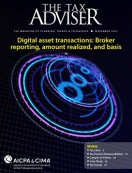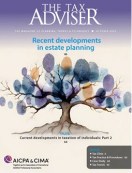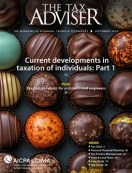- tax clinic
- TAX ACCOUNTING
IRS updates list of automatic changes
Related
Digital asset transactions: Broker reporting, amount realized, and basis
Applying updated ASC Topic 740 requirements for the income tax footnote
Income tax purchase accounting considerations for a stock acquisition
TOPICS
Editor: Mark G. Cook, CPA, CGMA
In Rev. Proc. 2023-24, the IRS has updated the list of accounting method changes for which the automatic change procedures of Rev. Proc. 2015-13 (as modified) apply. The new procedure, which replaces Rev. Proc. 2022-14, lists 29 significant modifications, including changes related to depreciation, research and development costs, overall cash and accrual methods, income recognition, and mark-to-market elections.
Key addition and changes
Following are some selected significant additions and changes, by section number of the revenue procedure, with comments on their application and effects.
Section 3.12, Natural gas transmission and distribution property method of accounting under Rev. Proc. 2023-15: This change of accounting method relates to a taxpayer that wants to change its treatment of natural gas transmission and distribution property costs to use the natural gas transmission and distribution property safe harbor method of accounting under Rev. Proc. 2023-15. A new paragraph is added to this section to clarify that if any asset is public utility property within the meaning of Sec. 168(i)(10), the taxpayer must attach a statement to its Form 3115, Application for Change in Accounting Method, providing that the taxpayer agrees to certain additional terms and conditions to make the change under Section 3.12. Another paragraph is added to clarify that a taxpayer must not include in the Sec. 481(a) adjustment any amount attributable to property for which the taxpayer elected to capitalize repair and maintenance costs under Regs. Sec. 1.263(a)-3(n) for any tax year in which this election was made.
Section 6.01, Impermissible to permissible method of accounting for depreciation or amortization: This section is modified to clarify that taxpayers can make a change from an impermissible to a permissible method of accounting for depreciation or amortization, even though the taxpayer has claimed a federal income tax credit, as long as the change does not affect the claimed federal income tax credit amount. This clarification is beneficial for taxpayers because previously, if a federal income tax credit was claimed, this automatic method change could not be used, regardless of its effect on the credit.
Section 7.02, Specified research or experimental expenditures: Taxpayers can change their method of accounting for specified research or experimental expenditures to the required Sec. 174 method. The section is modified to clarify that an allowable change includes a change from capitalizing specified research and experimental expenditures to inventoriable property or depreciable property and recovering those expenditures through cost of goods sold or depreciation, respectively.
Section 12.12, U.S. ratio method: This section, relating to a change to or within the U.S. ratio method, is clarified to provide that the Sec. 481(a) adjustment must be computed in the manner provided in Notice 88-104, as modified by Notice 89-67. In addition, a taxpayer completing the short Form 3115 must also complete Part IV of the form, except for Line 25.
Section 15.01, Change in overall method from the cash method, or from an accrual method with regard to purchases and sales of inventories and the cash method for all other items, to an accrual method: This section is modified to clarify that it applies to a taxpayer that wants to make this automatic change in overall method. The section is also modified to remove the defined term “hybrid method.” However, this section continues to not apply to a taxpayer that uses any other combination of the cash method and an accrual method as its present overall method of accounting. In addition, the statement requirement in Section 15.01(3) (b) of Rev. Proc. 2023-24 is modified to remove the requirement for a taxpayer with an applicable financial statement that changes to an accrual method under Section 15.01 of Rev. Proc. 2023-24, but the taxpayer is still required to complete Line 3 of Schedule B of Form 3115.
Section 16.08, Changes in the timing of income recognition under Secs. 451(b) and (c): Rev. Proc. 2023-24 extends the eligibility waiver of the five-year rule for one additional year with regard to changes under Section 16.08(2)(a)(i), (2)(a)(ii), or (2)(b) of the revenue procedure, for a taxpayer’s first or second tax year beginning on or after Jan. 1, 2021, if a taxpayer did not apply Regs. Secs. 1.451-3, 1.451-8, and/or 1.1275-2(l) to a tax year beginning before Jan. 1, 2021.
This is a welcome clarification for taxpayers who did not file a 2022 method change request, because they could now make the change for 2022 under the automatic instead of nonautomatic accounting method change provisions (no later than the due date for their 2022 tax return). However, a taxpayer using the five-year eligibility waiver may need to take any remaining balance of the prior Sec. 481(a) adjustment into calculation of taxable income for the year of change. And any positive Sec. 481(a) adjustment from the current change must take it in full (no offset with the prior year’s negative Sec. 481(a) adjustment) in computing taxable income for the year of change.
Section 24.01, Commodities dealers, securities traders, and commodities traders electing to use the mark-to-market method or (f): This section clarifies that if a taxpayer makes a timely election under Sec. 475(e) or (f), as applicable, and the taxpayer’s method of accounting for its tax year immediately preceding the election year is inconsistent with Sec. 475, such a taxpayer is required to change its method of accounting by filing a Form 3115. Unless it is the first tax year in which the taxpayer owns securities or commodities, as applicable, a Form 3115 is required to be filed with the federal income tax return for the year of change in accordance with the procedures provided in Section 6.03(1) of Rev. Proc. 2015-13. However, if a taxpayer has revoked a previous Sec. 475(e) or (f) election within the five tax years ending with the election year, then the taxpayer may not use the automatic change procedures.
Section 24.02, Taxpayers requesting to change their method of accounting from the mark-to-market method of accounting described in Sec. 475 to a realization method: This section is modified to clarify that taxpayers are required to file a Form 3115 with the federal income tax return for the year of change in accordance with Section 6.03(1) of Rev. Proc. 2015-13, as well as filing the notification statement required under Section 24.02(7) of Rev. Proc. 2023-24. However, the section is also clarified to provide that automatic changes are not available if any of the following scenarios apply: (1) The taxpayer has revoked a previous Sec. 475 election within the five tax years ending with the new election year; (2) the taxpayer wishes to revoke a Sec. 475 election and change to the realization method within five years of the election year; or (3) a dealer in securities, as defined in Sec. 475(c)(1), requests to change to the realization method.
Obsolete sections
Rev. Proc. 2023-24 removes the following obsolete sections:
- Section 6.18, relating to late elections or revoking elections under Secs. 168(k)(5), (7), and (10);
- Section 12.18, relating to the revocation of a historic absorption ratio election;
- Section 16.06, relating to advance payments; and
- Section 16.09, relating to changes in timing of recognition of income due to the new standards.
Effective date and transition rules
Rev. Proc 2023-24 is effective for Forms 3115 filed on or after June 15, 2023, for a year of change ending on or after Oct. 31, 2022. In addition, the IRS has provided transition rules if a taxpayer filed the Form 3115 before June 15, 2023, and the form is pending.
More specifically, if a taxpayer is eligible to use the automatic change procedures in Rev. Proc. 2023-24 but filed a Form 3115 under the nonautomatic change procedures in Rev. Proc. 2015-13 before June 15, 2023, and the form was pending with the National Office on June 15, 2023, the taxpayer could choose to make the change in method of accounting under the automatic change procedures in Rev. Proc. 2015-13 by notifying the National Office contact person of the taxpayer’s intention before the later of (1) July 17, 2023, or (2) the issuance of a letter ruling granting or denying consent for the change. The taxpayer is qualified for a user fee refund. Also, the taxpayer must resubmit a Form 3115 that conforms to the automatic change procedures, attaching a copy of the letter from the National Office acknowledging the taxpayer’s request, to the IRS in Ogden, Utah, by the earlier of (1) the 30th calendar day after the date of the National Office’s letter, or (2) the date the taxpayer must file the duplicate of the Form 3115 under Section 6.03(1)(a)(i)(B) of Rev. Proc. 2015-13.
If a taxpayer filed 2022 method change requests under automatic procedures that no longer qualify for automatic procedures in Rev. Proc. 2023-24, the taxpayer is still allowed to implement the automatic change procedures under Rev. Proc. 2022-14 if they properly filed the original or a duplicate copy of the Form 3115 before June 15, 2023. Otherwise, the taxpayer must submit a nonautomatic Form 3115 to request to change the accounting method for the taxpayer’s last tax year ending prior to June 15, 2023, provided they do so on or before the due date of the federal income tax return, including extensions, notwithstanding that the taxpayer may not have extended the due date.
Editor Notes
Mark G. Cook, CPA, CGMA, MBA, is the lead tax partner with SingerLewak LLP in Irvine, Calif.
For additional information about these items, contact Cook at mcook@singerlewak.com.
Contributors are members of or associated with SingerLewak LLP.














